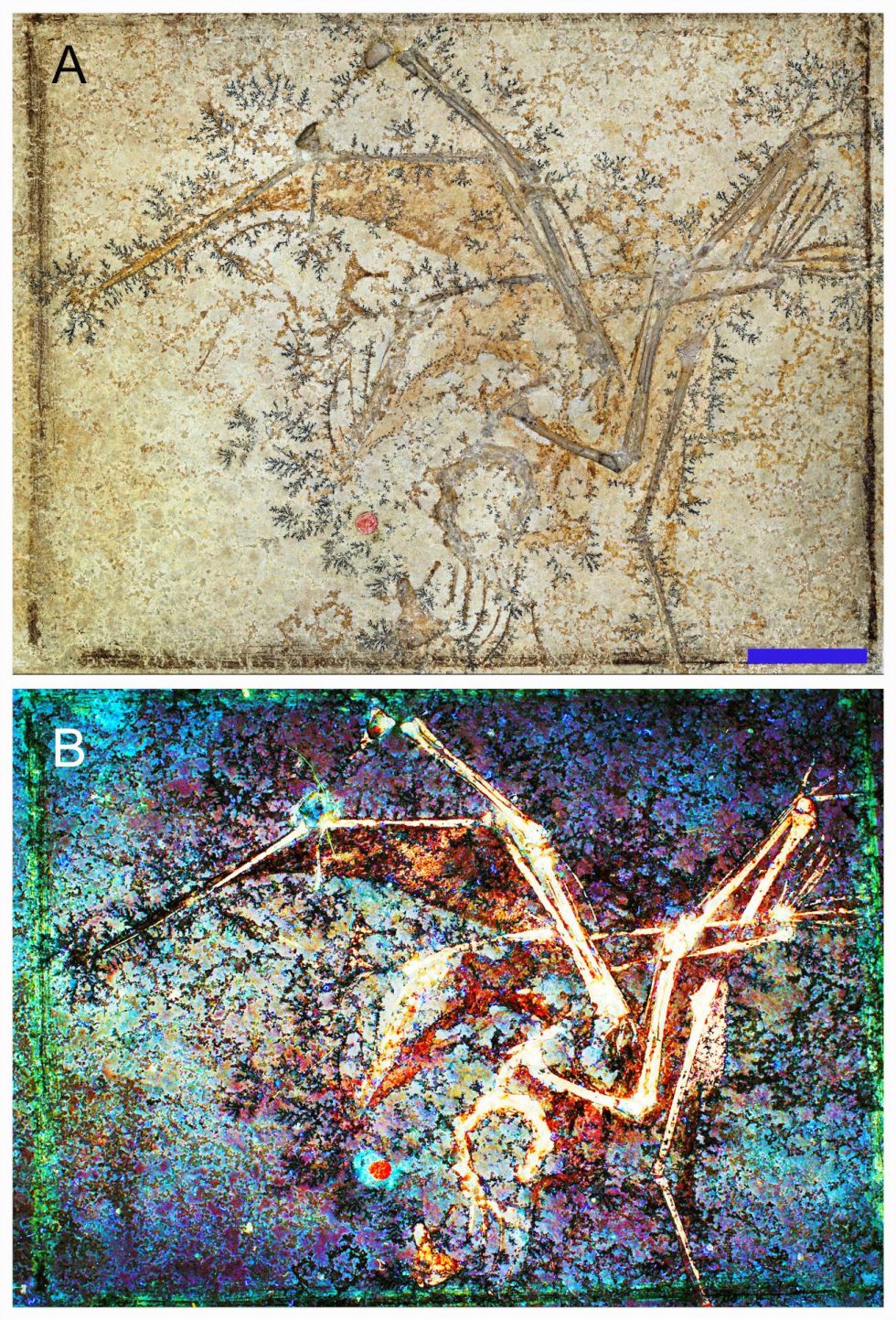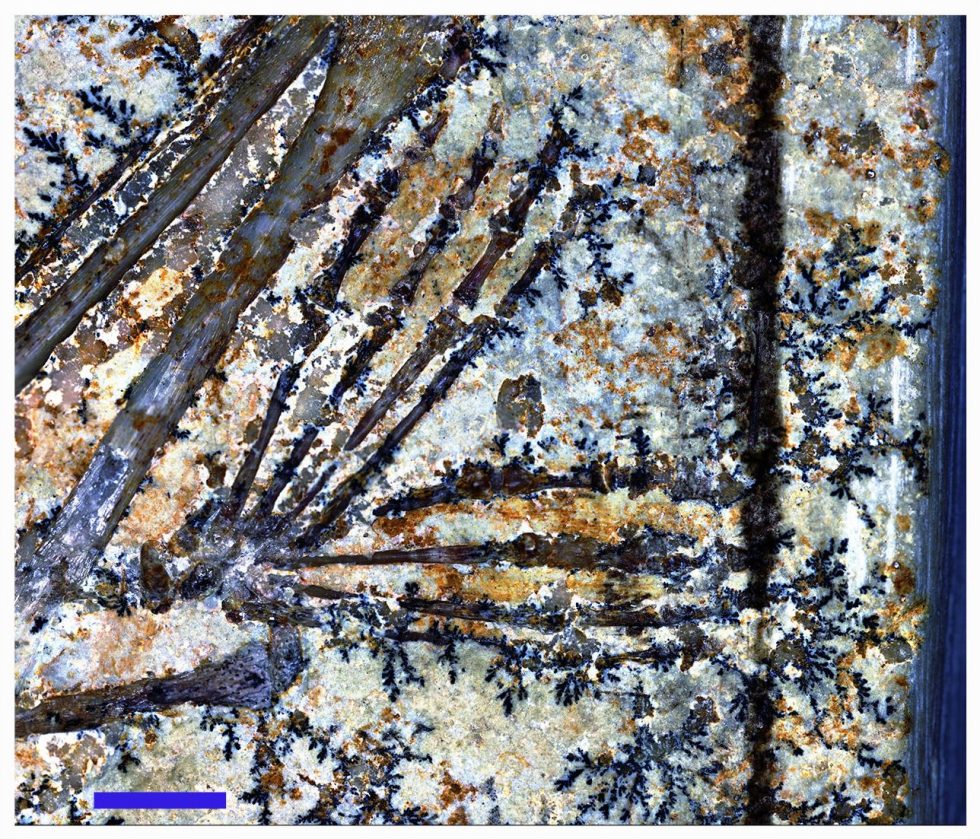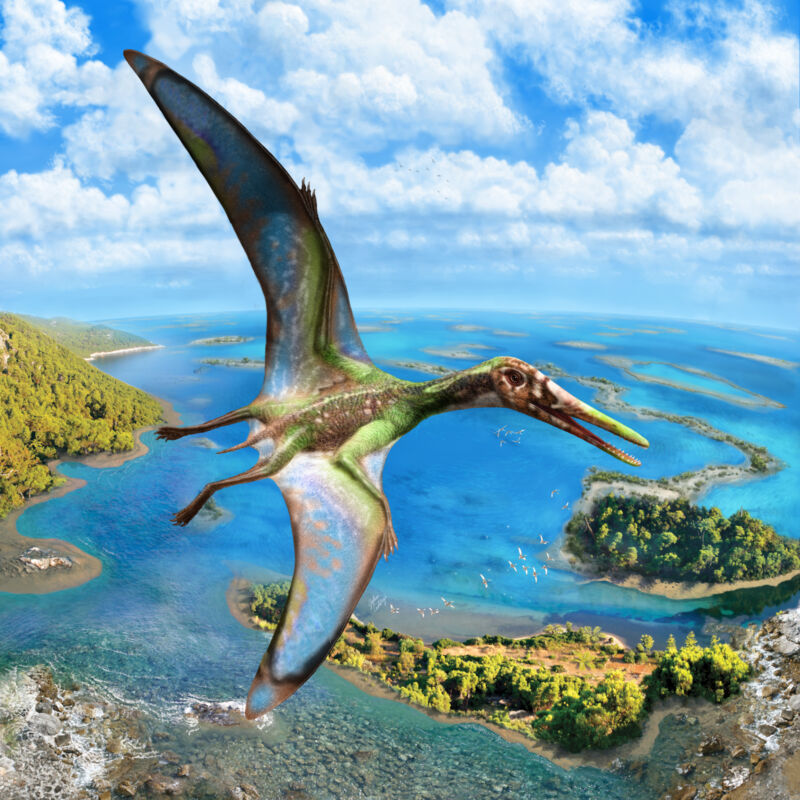A group of researchers has recently made an astounding discovery.
Using an innovative imaging technique, an international team of scientists has uncovered remarkable details of a pterosaur's soft tissue. Despite an age of approximately 145–163 million years, the wing membrane and the webbing between both feet managed to survive fossilization.
Armed with new data, the team used modeling to determine that this little pterosaur had the capacity to launch itself from the water. Their findings are published in Scientific Reports.
Fine details
Pterosaurs—an extinct type of winged reptile—were the first known vertebrates to take to the air and fly. Their sizes ranged from the very tiny (a wingspan of 25 centimeters) to the absolutely enormous (a breathtaking 10- to 11-meter wingspan). According to the lead researcher on the new work, Dr. Michael Pittman, the small aurorazhdarchid that was studied could have fit in the palm of your hand. Of 12 well-preserved pterosaurs from the Solnhofen Lagoon in Germany, it was the only one with preserved soft tissues.
Dr. Pittman is a paleobiologist and assistant professor at the Chinese University of Hong Kong, and co-author Dr. Thomas G. Kaye is with the Foundation for Scientific Advancement. The authors noted that this pterosaur is now among only six known pterosaurs with evidence of webbed feet and approximately 30 with wing membranes.
"We are constantly amazed by just how stunning the preserved details can be," Dr. Pittman told Ars, "which keeps getting better and better as we refine the technique more and more."
The ability to detect these soft tissues and bring them into sharp relief through laser-stimulated fluorescence (LSF) is relatively new. LSF is a non-destructive imaging technique that has been taken to new levels by Dr. Pittman and Dr. Kaye.
"As part of a larger, ongoing project," Dr. Pittman said, "we have been using LSF to reveal otherwise hidden soft tissues preserved in fossils. A key focus has been to use LSF to study feathered dinosaurs and pterosaurs to better understand their biology and flight evolution."
Ready for takeoff?
In this case, understanding the pterosaur's biology involved determining whether this Late Jurassic creature could take off from the water. Just because the pterosaur had webbed feet, the researchers emphasized, doesn’t necessarily mean it spent time in the water, nor does it indicate that it could get out of the water if it happened to fall in.
The work was incredibly difficult and potentially contentious. It's one thing to try to determine locomotion in animals that have skeletons mirroring those that exist today; it’s an entirely different matter when that creature has no modern analogue.
"There’s a ton of debate about pterosaurs generally, about pretty much every aspect of their biology," Dr. Armita Manafzadeh told Ars. "And their joints are extra debated because they're just very bizarre."

Dr. Manafzadeh, who was not involved in this research, is a Donnelley Postdoctoral Fellow and NSF Postdoctoral Research Fellow at the Yale Institute for Biospheric Studies. Her work focuses on what’s called "arthrology": understanding joints, joint function, and movement in both extant and extinct species.
Figuring out the movement of extinct animals, she said, requires determining "what you think the animal was capable of, and that has its own challenges."
"But you also have to figure out, out of this range of capabilities, what did the animal actually do when it was alive," she said. "It might have been able to do it, but that doesn’t necessarily mean that it did it."
The team looked to Dr. Michael Habib, a self-described pterosaur aeromechanics specialist and one of only four people on the planet with that expertise, to help them analyze how these soft tissues could have impacted the reptile’s ability to fly and launch. Dr. Habib has studied birds and pterosaurs for years, and his unique knowledge base of physics, aerodynamics, and paleontology made his insights particularly relevant. The launch model used in this paper was an expansion of work Dr. Habib and his colleague did in 2010 to help determine whether large pterosaurs would have been able to launch from the water. He is a research associate with the National History Museum of Los Angeles and adjunct associate professor of Medicine at UCLA.
"I work on animal biomechanics and flight origins," Dr. Pittman said, "but I invited Dr. Mike Habib on the project because of his specific expertise on the flight of pterosaurs, which enabled the team to deliver the results we found."
Size and stickiness
Contrary to what one might expect, it tends to be more difficult to take off from the water at very small sizes than somewhat larger sizes.
Dr. Habib described how the force something has to overcome in order to escape a liquid is significantly impacted by the total contact surface area of any creature trying to lift itself from the surface. "If you’re small, you have a lot of surface relative to your volume and weight. So the surface tension is quite large relative to your mass and to your power output," he told Ars.
To put it another way, he said, "everything feels stickier when you’re small. A small pterosaur is living in a stickier world, and it’s got to break that tendency to stick to the surface."
Using a number of analyses, the team found evidence that this little pterosaur was a "quad-launcher": It used all four limbs—both front and hind—to propel itself off the water. This type of launch can be seen in today’s mallard ducks, which use both their webbed feet and wings to push out of water. Dr. Habib described how many other aquatic birds today are limited to the size of water they land in, as many need a larger runway to lift back out of it. Not so with mallards, which have earned the nickname "puddle-jumpers" for their capacity to get out of even the smallest bodies of water.
Capability vs. action
Little aurorazhdarchid pterosaurs appear to have been similar. But again, just because they could do something doesn’t mean they did.
"There’s enormous selective pressure for water-launch capacity for the animals that habitually feed in or around the water," Dr. Habib said. "One might expect that pterosaurs that were feeding in and around the water would have water-launch capacity, but it’s not a guarantee."
He stressed that the evidence suggests that webbed feet were an important part of this little pterosaur’s ability to push off from the water.
Dr. Manafzadeh was impressed with the paper’s transparency. “I think these authors really went above and beyond and just showed you exactly what numbers they were using and exactly what equations they were plugging them into," she said.
Pterosaur limb movement has been "hotly debated," she said with a laugh. She explained that previous papers have proposed extreme movement capabilities within pterosaur shoulders—“they require the animal’s shoulder to move a lot”—but in this paper, the authors’ models are based on a conservative range of possible motion. In other words, she said, the models show that even if it used a limited range of shoulder motion, this pterosaur could still launch from the water.
Wing mechanics
The preserved wing membrane, as seen through LSF, also offered rare evidence of what Dr. Habib describes as a kind of fiber, called "actinofibrils," running through the wing. Dr. Pittman described the fiber as “a very important support structure that we find in the wings and foot webbing of pterosaurs.”
The presence of actinofibrils offered important insight into an aspect of flying that anything—from birds to bats, airplanes, and pterosaurs—risks at certain speeds: aeroelastic flutter. This phenomenon refers to the vibrations a wing will undergo at high angles of attack or at high speeds. A very limited amount of flutter, Dr. Habib said, is OK. But when it reaches the point of extreme vibration—aeroelastic flutter—it’s almost like a flag flapping wildly in the wind. It’s unsafe.
“What we’ve been able to deduce from multiple wings that have soft-tissues preserved in the fossil record is that they’re doing two primary things in order to keep the wing from fluttering,” Dr. Habib said. “One of them is active control.” He explained that pterosaur wings contain a lot of muscle, and that muscle can contract to prevent the wing from vibrating.
“But,” he continued, “they also have passive stiffening of the wing.” That stiffening is done through a “highly keratinized” wing surface, but also from the presence of actinofibrils. “When the wing starts to automatically curve and starts to stretch, and it’s going to flutter, those actinofibrils will go taut.”
Despite all of these new details, it’s difficult to know how all the features were used by the pterosaurs. Dr. Manafzadeh feels that the paper could have gone even further in that direction.
“I think they make a pretty convincing case for the capabilities,” Dr. Manafzadeh said, “but it’s less clear whether the animal actually did it. If you really wanted to test whether the animal did it in life, that would require other lines of evidence that aren’t in the paper.” For example, further studies could investigate the "sizes of muscle scars on the bones, [as they] might tell you how much force the muscle generated in life and in what directions," she said.
But the authors maintain that their "prior work on pterosaur locomotion has included measurements of bone properties that provide direct information of real in-life loads, similar to what is suggested."
"Given that pterosaurs are extinct," the researchers said, "we can’t really say anything more than what they were capable of. But data like muscle scar shape and size would provide additional support.”
Dr. Manafzadeh explained that "our capacity to go beyond saying just what extinct animals were capable of and to more accurately pinpoint what they actually did in life has dramatically improved in the past five to 10 years—so I wouldn't rule out being able to more confidently answer this question one way or another in the near future. Either way, it will be a very interesting result.”
Model flyers?
Reconstructing possible flight from creatures that lived hundreds of millions of years ago is astounding in and of itself, but this ancient flight capability may also have modern applications.
When Dr. Manafzadeh was asked how studying ancient articulation could help us today, she had a quick answer: robots. She is not impressed with the human range of movement, saying we "move in a kind of boring way, honestly." Modeling robot locomotion on animals—extinct and extant—would be, in her opinion, much more interesting. In this way, engineers constructing robots would be "looking at a sea of diversity of locomotor modes that have evolved over 500 million years," she said.
Dr. Habib mentioned that pterosaur flight capabilities might influence "next-generation rotor aircraft," i.e., helicopters. He described how helicopter blades sag when idle but rise up in motion. The performance of those blades, he noted, is improved by being flexible rather than stiff. But if the blades are too thin, there’s a very real danger of aeroelastic flutter. The Department of Defense is interested in how animals, who have much softer wings than any helicopter or airplane, solve the aeroelastic flutter problem. In other words, they are interested in the flight capabilities of birds, bats, and, yes, pterosaurs.

“This is not a widespread thing yet in terms of lots of DOD projects looking at pterosaurs. There is a project,” he said, “which I’m involved in.” But it has only been pitched to the DOD and hasn’t yet been formally accepted. Nevertheless, the interest is there, he said.
Regardless of any future utility, this sort of research offers detail rarely seen in the fossil record and opens up a world of potential new studies.
“If you [told] me when I was a budding young paleontology student that we would be using lasers to take photos of hidden soft tissues in dinosaurs and pterosaurs in the future, I would have asked if you were pranking me or sharing a storyline for an upcoming comic book,” Dr. Pittman said. “What I know based on LSF and other recent technological advances is that new technology will allow us to detect more and more detail from fossils, detail that we didn’t know was there and detail that we never thought we could detect.”



3175x175(CURRENT).thumb.jpg.b05acc060982b36f5891ba728e6d953c.jpg)

Recommended Comments
There are no comments to display.
Join the conversation
You can post now and register later. If you have an account, sign in now to post with your account.
Note: Your post will require moderator approval before it will be visible.